The Council for the Indian School Certificate Examinations (CISCE) releases the ISC Class 12 Physics Specimen Paper on its official website every year. The ISC Physics Specimen paper 2025 Solved has been provided below for the students so that they do not have to go through the headache of surfing the internet. Physics is an important subject in the curriculum of the ISC Class 12 Science stream. The subject has a mix of both theoretical and numerical concepts.
To ace the ISC Class 12 Physics exam 2025 which is going to start in February, one needs to practice the official specimen paper released by the council. The Indian School Certificate (ISC) exam is an important part of any student’s life as it decides the future academic scope of the students. So, students must give their full to prepare for the exam. In this process, the specimen paper is an important resource that will guide students to achieve good marks.
ISC Class 12 Physics Specimen Paper 2025 Solved
For students preparing to sit for the board exam in the forthcoming 2024–2025 session, CISCE has released the Class 12 Physics Specimen Paper 2025 along with the answer key has been released on its official website. Students can now also download the official ISC Class 12 Physics Specimen Paper 2025 Solved PDF from this page. The Specimen paper that the CISCE education board provided has the updated question formats and the updated exam layout.
One useful tool that will help you prepare for the test is the ISC Class 12 Physics Specimen Paper for 2025. Make smart use of it to pinpoint your areas of strength and weakness, hone your problem-solving techniques, and obtain a thorough grasp of the format of the exam. Regular practice on specimen paper along with a comprehensive rewrite of the syllabus can increase your self-assurance and exam readiness.
Class 12 ISC Physics Specimen Paper 2025
The ISC 12th Physics exam paper consists of an array of questions containing different types of questions. The ISC Class 12 Physics Specimen Paper 2025 helps students to delve deeper into the fascinating field of physics, not merely for exam preparation. The instructions given in the ISC Class 12 Specimen Paper will be the same as in the actual theory exam paper. For this purpose, we are providing students with the important instructions given in the ISC Class 12 Physics Specimen Paper 2025.
- This paper is divided into four sections – A, B, C and D.
- Answer all questions.
- Section A consists of one question having sub-parts of one mark each.
- Section B consists of seven questions of two marks each.
- Section C consists of nine questions of three marks each, and
- Section D consists of three questions of five marks each.
- Internal choices have been provided in two questions each in Section B, Section C and Section D.
- The intended marks for questions are given in brackets [ ].
- All working, including rough work, should be done on the same sheet as and adjacent to the rest of the answer.
- Answers to sub parts of the same question must be given in one place only. A list of useful physical constants is given at the end of this paper.
- A simple scientific calculator without a programmable memory may be used for calculations.
ISC Class 12 Physics Specimen Paper 2025 PDF
The ISC Class 12 Physics subject calls for a flexible approach to preparation in addition to the appropriate set of preparation techniques. After extensive investigation, subject matter specialists prepared these ISC 12th Physics sample papers. This examination follows the most recent exam format and includes all of the major topics covered in the ISC Class 12 Physics Syllabus.
Before the board exam, students will gain valuable practice by completing the Class 12 Physics ISC Specimen Paper 2025. They also learn where they stand right now in terms of readiness by solving the official specimen paper 2025. For this reason, the PDF for the ISC Class 12 Physics Specimen Paper 2024-25 is provided to students below.
ISC Class 12 Physics Specimen Paper 2025 PDF
ISC Class 12 Physics Previous Year Specimen Paper Questions
Section A – 14 Marks
Question 1
(A) In questions (i) to (vii) below, choose the correct alternative (a), (b), (c) or (d) for each of the questions given below:
(i) Two bulbs of power ratings 100 W and 40 W, designed to operate on the same voltage, are connected in parallel to a battery source as shown in Figure 1 below. Currents flowing across points 1,2 and 3 are I1, I2 and I3 respectively. [1]
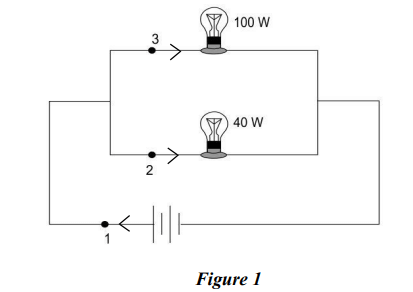
Choose the correct option.
(a) I1 > I2 > I3
(b) I1> I2 < I3
(c) I1 < I2 = I3
(d) I1 > I2 = I3
(ii) A circular coil having N turns of radius R carries a current I and produces a magnetic field T at its centre O.
If this coil is opened and rewound such that the radius of the newly formed coil is 2R, and the same current I passed through it, the magnetic field at the centre O will be: [1]
(a) 2T
(b) T
(c) T/2
(d) T/4
(iii) Assertion: Magnetic lines of force do not intersect each other.
Reason: At the point of intersection, the magnetic field will have two directions. [1]
(a) Both Assertion and Reason are correct, and Reason is the correct explanation for Assertion.
(b) Both Assertion and Reason are correct, but Reason is not the correct explanation for Assertion.
(c) Assertion is true and Reason is false.
(d) Assertion is false and Reason is true.
(iv) The focal length of a double convex lens is equal to the radius of curvature of either surface. The refractive index of its material is: [1]
(a) 3/2
(b) 1
(c) 4/3
(d) Zero
(v) Which one of the following statements is correct in case of Fraunhofer’s single slit diffraction experiment? [1]
(a) All bright fringes are of same intensity.
(b) Central bright fringe is the brightest.
(c) Central fringe is a dark fringe.
(d) Angular width of central fringe increases with an increase in wavelength of the incident monochromatic light.
(vi) The de Broglie wavelength of a moving particle varies: [1]
(a) directly with its velocity.
(b) directly with its momentum.
(c) directly with its kinetic energy.
(d) inversely with its linear momentum.
(vii) Which one of the following statements is correct with reference to Semiconductor Physics? [1]
(a) N type semiconductor has a majority of holes.
(b) To convert a pure semiconductor into a P type semiconductor, Phosphorous is used as a dopant.
(c) In energy band diagram of a metal, forbidden band is absent.
(d) Resistance of a semiconductor increases on increasing its temperature.
(B) Answer the following questions briefly:
(i) State any one advantage of a full wave rectifier over that of a half wave rectifier. [1]
(ii) State the condition for a balanced Wheatstone bridge. [1]
(iii) Name the rule used to determine the direction of induced current in the case of a straight conductor moving in a magnetic field. [1]
(iv) With what type of source of light are plane wave fronts associated? [1]
(v) Write an expression for the torque acting on an electric dipole kept in a uniform electric field in vector form. [1]
(vi) In Young’s double slit experiment, what should be the path difference between two overlapping waves to form a bright band / fringe? [1]
(vii) What are isotones? [1]
Section B – 14 Marks
Question 2 [2]
(i) (a) State Gauss’ theorem.
(b) What is the SI unit of electric flux?
OR
(ii) Calculate the equivalent capacitance C´ if n identical capacitors each of capacitance C are connected in series.
Question 3 [2]
A hollow charged metallic sphere of radius R carries a charge Q. How much work has to be done in moving a charge q on its surface through a distance d? Explain.
Question 4 [2]
(i) What is meant by pair annihilation?
(ii) Give any one example where energy is converted to matter.
Question 5 [2]
(i) Figure 2 given below shows a part of Wheatstone bridge circuit. With the help of Kirchhoff’s loop rule, calculate the current flowing through the 4Ω resistor.
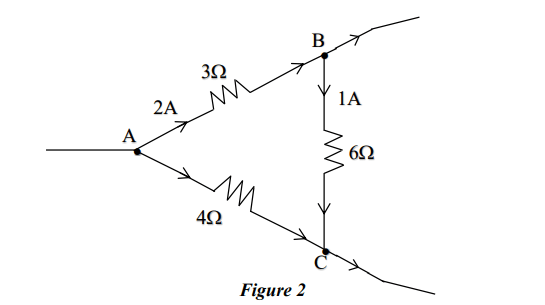
OR
(ii) In an experiment conducted to determine the internal resistance of a cell, its emf is balanced against a p.d. across 110cm of the potentiometer wire. The balancing length becomes 100cm when the cell is shunted by a resistance of 10Ω. Calculate the internal resistance of the cell.
Question 6 [2]
(i) On which principle do optical fibres work?
(ii) What is a thin prism?
Question 7 [2]
(i) State any one application of microwaves.
(ii) Which one of the following rays/waves is NOT an electromagnetic wave? X rays; UV rays; γ rays; matter waves.
Question 8 [2]
(i) What is motional emf?
(ii) A 220V ac voltage is to be converted to 33,000V ac voltage. What kind / type of transformer will you use?
Section C – 27 Marks
Question 9 [3]
Obtain an expression for intensity of electric field at a point in broadside position of an electric dipole.
Question 10 [3]
(i) In Figure 3 shown below, all the cells are identical. The external resistance R is also same in both the circuits.
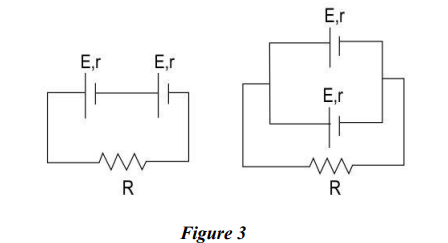
If the same current flows through the resistor R in both the circuits, calculate the relation between r, the internal resistance of each cell and the external resistance R.
OR
(ii) The drift velocity of electrons in a conductor connected to a battery is given by
v = -eEτ/m.
Here, e is the charge of the electron, E is the electric field, τ is the average time between collisions and m is the mass of the electron.
(a) How does the drift velocity change with an increase in the potential difference across the conductor?
(b) A copper wire of length ‘l’ is connected to a source. If the copper wire is replaced by another copper wire of the same area of cross-section but of length ‘4l’, how will the drift velocity change? Explain.
Question 11 [3]
A galvanometer of resistance 100 Ω gives a full-scale deflection for a potential difference of 200 mV.
(i) How will you convert this galvanometer into an ammeter of the range 0 – 2A?
(ii) Define an ampere in terms of force between two current carrying conductors.
Question 12 [3]
(i) (a) Draw the ray diagram of a compound microscope t when the final image lies at the least distance of distinct vision, D.
(b) Write an expression for magnifying power of an astronomical telescope when final image lies at infinity. (No derivation required)
OR
(ii) For refraction at convex spherical surface of denser medium η2 surrounded by a rarer medium of refractive index η1, derive a formula connecting object distance u, image distance v, and radius of curvature R for the object in rarer medium and a real image formed inside the denser medium.
Question 13 [3]
Using Huygen’s wave theory, prove Snell’s Law for refraction of light.
Question 14 [3]
(i) A certain metal emits photoelectrons with a green light but not with a yellow light. If this surface is illuminated with blue light and red light, which one of the two will cause photoelectric emission? Give a reason for your answer.
(ii) What conclusion can be drawn from this phenomenon regarding the nature of light?
Question 15 [3]
A lens of focal length f is divided into two equal parts as shown in Figure 4A below. These parts are then arranged as shown in Figure 4B below.
In terms of the original focal length f,
(i) What is the focal length of the lens L1 ?
(ii) What is the focal length of the final combination?
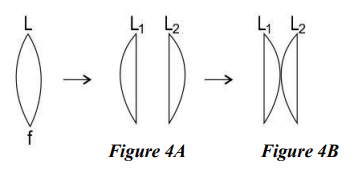
Question 16 [3]
Using Ampere circuital law, obtain an expression for magnetic field B near a long current carrying straight conductor.
Question 17 [3]
Young’s double-slit experiment is performed by a student. The examiner gives the following instructions to the student. State whether the responses of the student, in each case, are correct or incorrect. Give a reason for your answer.
(i) EXAMINER: The fringes on the screen are too crowded. Increase the distance between the fringes.
STUDENT increases the distance between the two slits (thinking that distance between the fringes increases on increasing the distance between slits).
(ii) EXAMINER: Bright fringes are not very bright. Increase their brightness. STUDENT moves the source of light towards the two slits.
(iii) EXAMINER: Compare the distance between central and first maxima with the distance between second and third maxima.
STUDENT measures and states that the distance between central and first maxima is MORE than that between second and third maxima
How ISC Physics Model Paper help students?
You can improve your exam score by finishing the ISC Class 12 Physics Specimen Paper. Students will receive much higher grades if they examine the specimen paper. Students get a comprehensive understanding of the exam’s framework, scoring system, and possible question types.
By being familiar with the exam paper’s format and subject matter, students may prioritize their important concepts, better manage their time, and modify their study schedules. Additionally, this will enable students to properly arrange their Physics course syllabus.

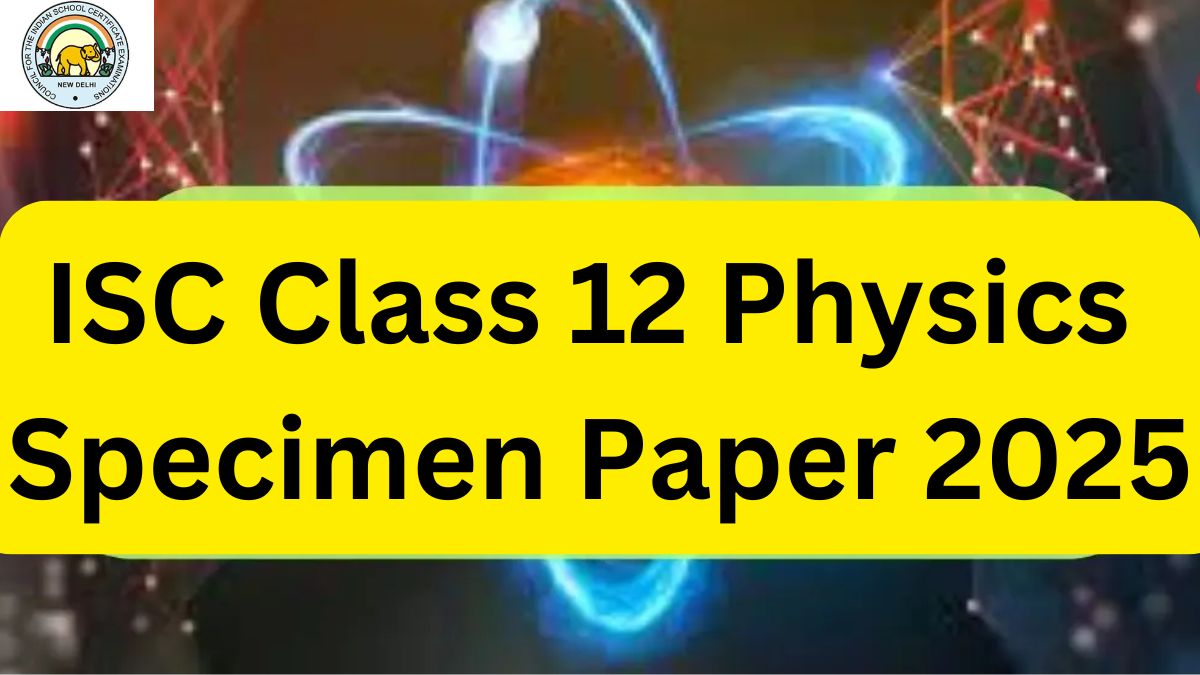







 AILET Sample Paper 2026 Out, Download PD...
AILET Sample Paper 2026 Out, Download PD...
 CBSE Class 10 IT Sample Paper 2025-26 PD...
CBSE Class 10 IT Sample Paper 2025-26 PD...
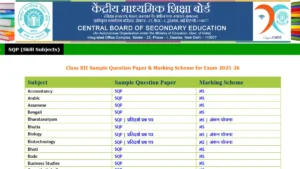 CBSE Class 12 Sample Paper 2026 with Sol...
CBSE Class 12 Sample Paper 2026 with Sol...














